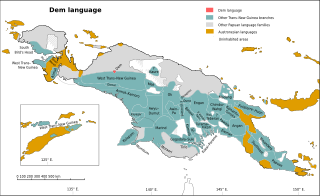Related Research Articles
The Sepik–Ramu languages are an obsolete language family of New Guinea linking the Sepik, Ramu, Nor–Pondo, Leonhard Schultze (Walio–Papi) and Yuat families, together with the Taiap language isolate, and proposed by Donald Laycock and John Z'graggen in 1975.

The East Geelvink Bay or East Cenderawasih languages are a language family of a dozen Papuan languages along the eastern coast of Geelvink Bay in Indonesian Papua, which is also known as Sarera Bay or Cenderawasih.

The Inland Gulf languages are a family of Trans–New Guinea languages in the classifications of Stephen Wurm (1975) and Malcolm Ross (2005). The unity of the languages was established by K. Franklin in 1969. Although the family as a whole is clearly valid, Ipiko is quite distinct from the other languages.
The Mabuso languages are a small family of closely related languages in New Guinea. They were linked with the Rai Coast languages in 1951 by Arthur Capell in his Madang family, which Wurm (1975) included in his Trans–New Guinea (TNG) phylum. Malcolm Ross reconstructed the pronouns of proto-Mabuso and noted that "the integrity of the Mabuso group is fairly obvious".
The Rai Coast languages are a family of languages in the Madang stock of New Guinea.

The Madang or Madang–Adelbert Range languages are a language family of Papua New Guinea. They were classified as a branch of Trans–New Guinea by Stephen Wurm, followed by Malcolm Ross. William A. Foley concurs that it is "highly likely" that the Madang languages are part of TNG, although the pronouns, the usual basis for classification in TNG, have been "replaced" in Madang. Timothy Usher finds that Madang is closest to the Upper Yuat River languages and other families to its west, but does not for now address whether this larger group forms part of the TNG family.
Momuna (Momina), also known as Somahai, is a Papuan language spoken in the highlands of Papua province, Indonesia.
The Ramu languages are a family of some thirty languages of Northern Papua New Guinea. They were identified as a family by John Z'graggen in 1971 and linked with the Sepik languages by Donald Laycock two years later. Malcolm Ross (2005) classifies them as one branch of a Ramu – Lower Sepik language family. Z'graggen had included the Yuat languages, but that now seems doubtful.
The Demta–Sentani languages form a language family of coastal Indonesian Papua near the Papua New Guinea border.

Dem is a divergent Papuan language of West New Guinea. Although Palmer (2018) leaves it unclassified, it was tentatively included in the Trans–New Guinea family in the classification of Malcolm Ross (2005), and Timothy Usher ties it most closely to Amung.

Mor is a nearly extinct Trans–New Guinea language of Indonesia. It is spoken along the Budidi River and the Bomberai River on the Bomberai Peninsula.
Molof is a poorly documented Papuan language spoken by about 200 people in Molof village, Senggi District, Keerom Regency.
Ipiko is a Papuan language of Papua New Guinea, the most divergent of the Inland Gulf languages. Despite being spoken by only a few hundred people, language use is vigorous. It is spoken in Ipiko and Pahemuba villages, with Ipiko village being located in Amipoke ward, Baimuru Rural LLG, Kikori District, Gulf Province.
Apalɨ (Apal), or Emerum, is a Papuan language of Madang Province, Papua New Guinea. Akɨ and Acɨ are two dialects that are quite different from each other.
Kambota.k.a.Ap Ma, is a Keram language of Papua New Guinea. Compared to its nearest relative, Ambakich, Kambot drops the first segment from polysyllabic words.
Yetfa and Biksi are dialects of a language spoken in Jetfa District, Papua, Indonesia, and across the border in Papua New Guinea. It is a trade language spoken in West Papua up to the PNG border.
Foia Foia (Foyafoya), or Minanibai, is a Papuan language of Papua New Guinea, spoken in an area near Omati River mouth in Ikobi Kairi and Goaribari Census districts.
The South Adelbert or Southern Adelbert Range languages are a family of languages in the Madang stock of New Guinea, spoken along the tributaries of the Ramu River in the watershed of the Adelbert Range.
The Leonhard Schultze or Walio–Papi languages are a proposed family of about 6 Papuan languages spoken in the Sepik river basin of northern Papua New Guinea. They are spoken along the border region of East Sepik Province and Sandaun Province, just to the south of the Iwam languages.
John Z'graggen was a Swiss Roman Catholic priest, missionary, linguist, and anthropologist known for his extensive work on Papuan and Oceanic languages, especially the Madang languages. He has also documented languages in Sepik, Manus, and Gulf Provinces.
References
- 1 2 3 Mubami at Ethnologue (25th ed., 2022)

- ↑ Harald Hammarström, 2010: The status of the least documented language families in the world.
- ↑ Z'graggen, John A. 1975. Comparative wordlists of the Gulf District and adjacent Areas. In: Richard Loving (ed.), Comparative Wordlists I. 5–116. Ukarumpa: SIL-PNG. (Rearranged version of Franklin ed. 1973: 541–592) with typographical errors.)